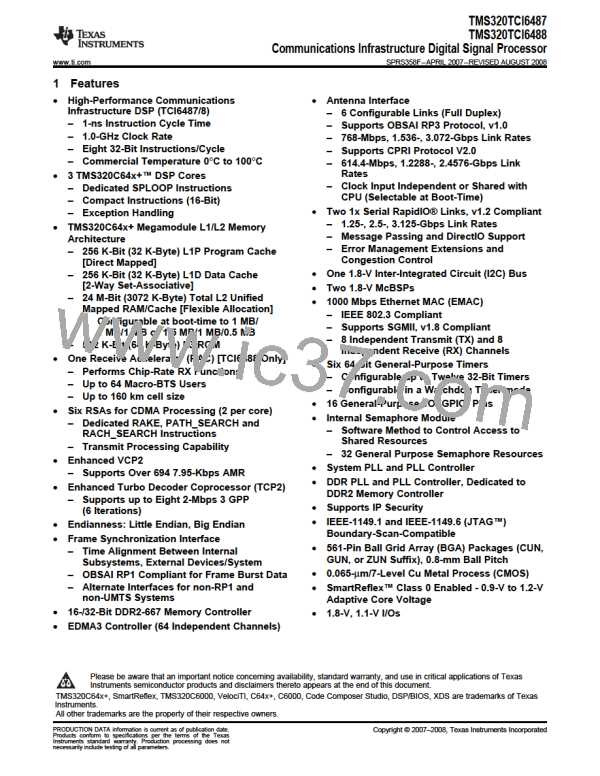TMS320TCI6487
TMS320TCI6488
Communications Infrastructure Digital Signal Processor
SPRS358F–APRIL 2007–REVISED AUGUST 2008
www.ti.com
1. XWRST pin is pulled active low for a minimum of 24 CLKIN1 cycles. The reset signals flow to the
modules reset by warm reset and sends a tri-state signal to most the I/O pads, to prevent off chip
contention.
2. Once all logic is reset, RESETSTAT is driven active to denote that the device is in reset.
3. XWRST pin can now be released. A minimal device initialization begins to occur. Note that
configuration pins are not re-latched and clocking is unaffected within the device.
4. After device initialization is complete, the RESETSTAT pin is de-asserted (driven high).
8.6.3 System Reset
System Reset is initiated by the emulator or by the RapidIO Module. It is considered a soft reset, meaning
memory contents are maintained, it does not affect the clock logic, or the power control logic of the
peripherals.
1. The RESETSTAT pin goes low to indicate an internal reset is being generated. The reset is allowed to
propagate through the system. Internal system clocks are not affected. PLLs also remain locked.
2. The boot sequence is started after the system clocks are restarted. Since the configuration pins
(including the BOOTMODE[3:0] pins) are not latched with a System Reset, the previous values, as
shown in the DEVSTAT register, are used to select the boot mode.
8.6.4 CPU Reset
(Timer 64 3, 4, and 5) can provide a local CPU reset if they are setup in watchdog mode. Timer64 3, 4,
and 5 are allowed to reset C64x+ Megamodule Core 0, C64x+ Megamodule Core 1, and C64x+
Megamodule Core 2, respectively.
8.6.5 Reset Priority
If any of the above reset sources occur simultaneously, the PLLCTRL only processes the highest priority
reset request. The reset request priorities are as follows (high to low):
•
•
•
•
Power-on Reset
Warm Reset
System Reset
CPU Reset
110
Peripheral Information and Electrical Specifications
Submit Documentation Feedback

 TI [ TEXAS INSTRUMENTS ]
TI [ TEXAS INSTRUMENTS ]